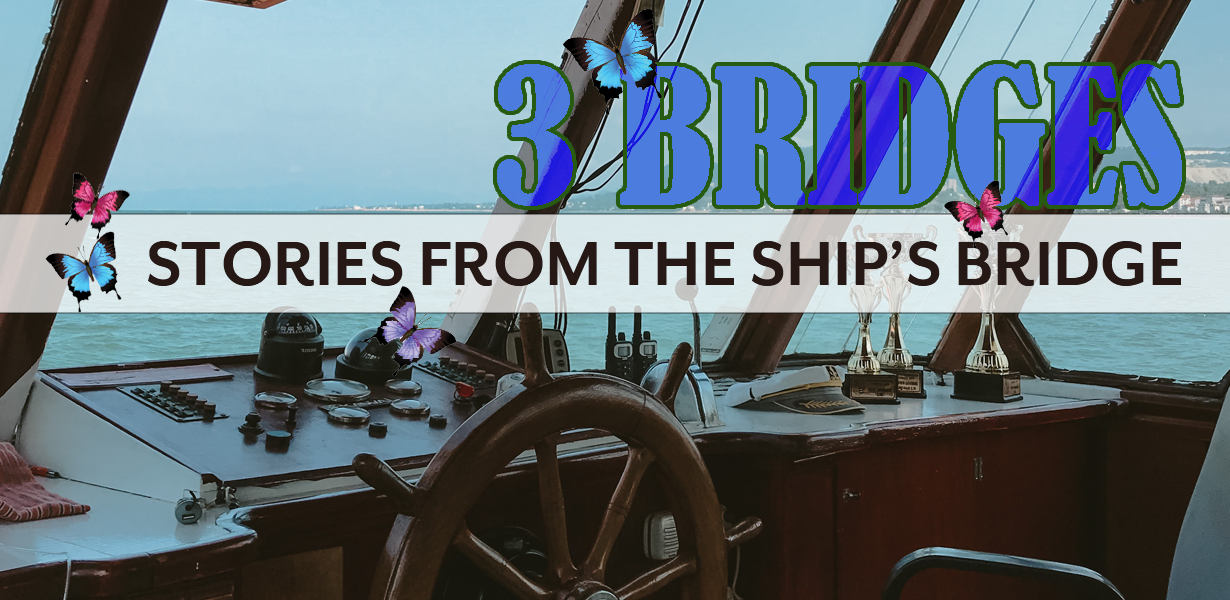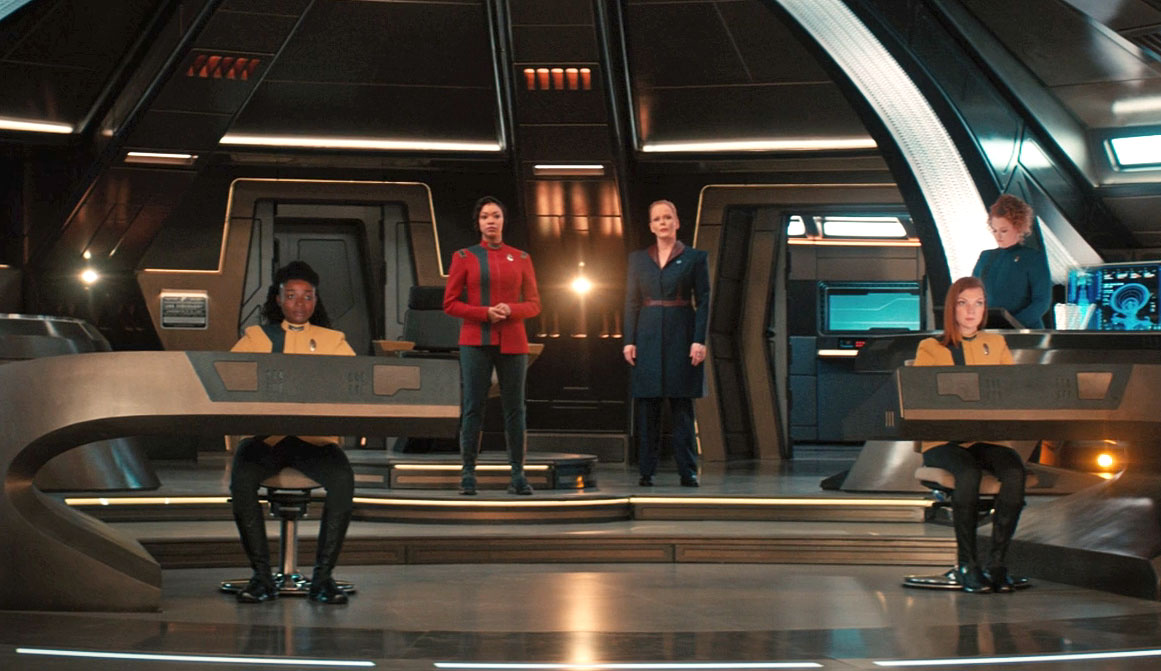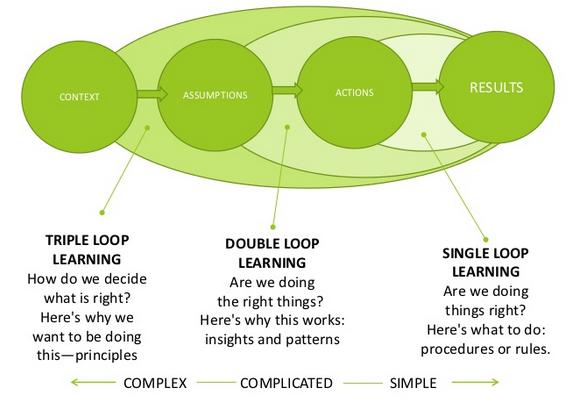Three Bridges: Stories from the Ship’s Bridge

by Nancy Carter, Evaluator
Introduction
In nautical and seafaring contexts, a ship’s bridge is an elevated platform from which the captain steers. From the bridge, the captain has a broad view of the ship and its surroundings, plus easy access to navigational tools. The captain has an enhanced perspective from which they can guide the crew, passengers, and cargo to its destination.
Captains use information from the ship’s operational tools along with their knowledge of the waters the ship is navigating, and in consideration of the people on board, working within the boundaries of the journey’s purpose and timeframe, abilities and limits of the ship’s crew, the nature of any cargo, and resources available for the voyage. Taking all this into account, the captain makes in-the-moment decisions and mid-course-corrections to steer through whatever is encountered along the way.
When applied to evaluation and learning this definition of a bridge conjures notions of complex system evaluations, which is common across most of Inspiring Communities (IC).
When asked to comment on the Ship’s Bridge metaphor, Executive Director Louise Adongo said that steering the IC ship with its strong culture of evaluation means all hands on deck as every member of the IC team has a role to play, although not everyone always plays every role. By integrating evaluation and learning in the collective work of the organization, IC team members collaborate to build the content for reflection, learning, evolution of the organization and transformation of systems. Doing so allows IC to benefit from sound evaluation practices and useful reports that are context-appropriate, timely, and relevant for navigating the organization’s journey, while also being used as a tool for engaging partners and collaborators to achieve the broader vision of the organization.
In this post, I use the Ship’s Bridge definition to share how IC has managed this approach to evaluation and learning, while linking observations of IC’s evaluation practice to current thinking in the field of evaluation.

Being a bridge: Navigating the seas as an Intermediary
IC has recently come to a renewed understanding of itself as an Intermediary Organization supporting equitable systems change. This means their work is focused not only at influencing policy and practices that support equitable systems change, but also at the formal and informal social structures, power dynamics, mental models, and institutional norms that hold systems in place and create barriers to transformation[1]. The obstacles IC encounters and works to overcome are found at all levels of systems, and across diverse issues and sectors including: social connection, agency, hope, resilience and trust, housing, transportation and mobility, climate change, youth employment, youth mental health, immigration and belonging, and arts based approaches to community vitality (to name a few).
IC is not alone in navigating these oceans; currently, many organizations are shaped by a context in which ‘facts’ are uncertain, complexity is the norm, values are disputable and unstable, stakes are high, processes of argumentation and bargaining between interest groups is common, and decisions are urgent[2]. However, Intermediaries like IC navigate many intersecting waters while also actively and purposefully shaping how those waters interact and flow to allow for a more equitable system to emerge.
For captains of such ships, a strong culture of evaluation and learning connected to a broader strategy provides guidance, fosters resilience through change, and supports sustainability as the oceans and ports encountered continue to evolve and transform in uncertain and complex ways. This approach requires leaders to share the broad view from the ship’s bridge with the evaluation team, so evaluation is designed in a way that is useful for supporting the mission and vision of the organization.
“New ways of thinking and forms of evaluation practice linked to models of adaptive planning and decision making are emerging.”
(Schwandt & Gates, 2021, p.113)
IC has relied on emerging evaluation theories and practices suited to handle such complexities. An evaluator is less of an external judge (as is the case in more traditional forms of evaluation) and more of an engaged partner supporting the captain and crew to “continuously make sense of pervasive social issues and inequalities and to steer a path of action through these difficult situations” (Schwandt & Gates, p.114). Schwandt & Gates propose the purpose of evaluation in such contexts requires rethinking from a task of determining valueto one of developing value.
The remainder of this post reflects on some of the evidence that the role and function of evaluation and learning at IC is evolving in alignment with this emerging framework for evaluation and in response to its own growth and influence.

Navigating from the Ships Bridge in Action at Inspiring Communities
First, the concepts of deep learning and developing value are reflected in IC’s vision: “Equitable, thriving communities built on fundamentally reimagined systems.” In pursuing this vision IC has moved from single-loop learning that is primarily focused on fixing a problem (i.e., evaluation is used for determining value in correcting a problem) to evaluation methods suitable for double-loop learning, which also reflects on what is causing the problem. Most recently, IC has moved into triple-loop learning, going deeper still to question longstanding assumptions and values that hold in place the systems in need of transformation. This means evaluations are expected to provide guidance for new courses of action and new system structures (i.e., evaluation is used for developing value in the system).

IC current strategic learning and evaluation system reflects this purpose and is built around a theory of change grounded by IC’s vision. Connecting evaluation to IC’s strategy and broadest vision allows evaluation to be used not only for accountability and reflection, but also as a tool for innovation and discovery as IC navigates the ocean of transformational system change to realize its vision. Schwandt and Gates note that in this approach to evaluation the overarching evaluation question becomes “Given what we know and what we can imagine is possible, what should we do now?”
Triple-loop learning encompasses earlier phases of learning resulting in high demand for evaluation at all levels of IC, which is why the captain needs ‘all hands on deck’ to meet the evaluation and learning needs of the organization.
There are risks to making evaluation a shared responsibility. For one, it is possible everyone will see evaluation and learning as someone else’s responsibility, resulting in a lack of accountability and engagement among staff in learning and evaluation. It is also a risk that the effort required is overlooked in job planning, leading to unrealistic budgets, insufficient resources and unmet expectations. Further, individual and team contributions to organizational learning and evaluation may go unrecognized, leading to demoralization and a lack of prioritization for evaluation and learning. For this reason, IC is working to enable comprehensive and useful evaluation by creating an organization-wide plan that clarifies roles of team members who support meaningful contributions to evaluation and learning.
Intermediaries like IC that aim to tackle pervasive issues such as equity sail the ever-changing seas incorporating many forms of learning, evaluation practice and theory as needed. The demands they meet at each port entered and each obstacle encountered may include storms, pirates, sea creatures (known, unknown and perhaps even mythical), or changing ocean temperatures. Along the way IC continues to be accountable, learn, and add value with support of its strategic learning and evaluation system. Though a final destination is stated in the vision, the mission and timeline are ever evolving, so IC relies upon its guiding principles as core to navigating its journey.
In an epilogue to this blog series, I will discuss these principles with reference to an Indigenous approach to learning called Etuaptmumk, or Two-Eyed Seeing, and a fourth definition of a bridge: the bridge of one’s nose.
Read previous posts:
- Three Bridges: IC’s Culture of Evaluation
- Three Bridges: Bridges that Connect
- Three Bridges: Sustaining and Using Bridges
References
[1] Kania, Kramer & Senge available online: https://www.fsg.org/resource/water_of_systems_change/
[2] Schwandt and Gates (2021) Evaluating and Valuing in Social Research. The Guilford Press, New York, NY
Image Credits
- Photo by Bilge Şeyma Kütükoğlu: https://www.pexels.com/photo/captain-control-cabin-in-a-boat-and-the-view-of-the-sea-8999950/
- Photo by Miguel Á. Padriñán: https://www.pexels.com/photo/paper-boats-on-solid-surface-194094/
Share this:
Comments are closed